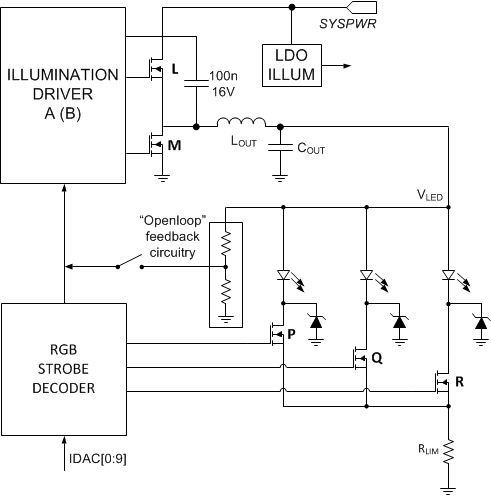ZHCSE87A October 2015 – September 2023 DLPA3000
PRODUCTION DATA
- 1
- 1 特性
- 2 应用
- 3 说明
- 4 Revision History
- 5 说明(续)
- 6 Pin Configuration and Functions
- 7 Specifications
-
8 Detailed Description
- 8.1 Overview
- 8.2 功能方框图
- 8.3
Feature Description
- 8.3.1 Supply and Monitoring
- 8.3.2 Illumination
- 8.3.3 DMD Supplies
- 8.3.4 Buck Converters
- 8.3.5 Auxiliary LDOs
- 8.3.6 Measurement System
- 8.3.7 Digital Control
- 8.4 Device Functional Modes
- 8.5 Register Maps
- 9 Application and Implementation
- 10Power Supply Recommendations
- 11Layout
- 12Device and Documentation Support
- 13Mechanical, Packaging, and Orderable Information
封装选项
机械数据 (封装 | 引脚)
- PFD|100
散热焊盘机械数据 (封装 | 引脚)
- PFD|100
订购信息
8.3.2 Illumination
The illumination function includes all blocks needed to generate light for the DLP system. To set the current through the LEDs accurately, use a control loop (Figure 8-4). The intended LED current is set through IDAC[9:0]. The Illumination driver controls the LED anode voltage VLED and as a result a current flows through one of the LEDs. The LED current is measured from the voltage across sense resistor RLIM. Based on the difference between the actual and intended current, the loop controls the output of the buck converter (VLED) higher or lower. Which LED conducts the current is controlled by switches P, Q, and R. The Openloop feedback circuitry ensures that the control loop can be closed for cases when there is no path through the LED; for example, when ILED= 0.
 Figure 8-4 Illumination Control Loop
Figure 8-4 Illumination Control LoopWithin the illumination block, the following blocks can be distinguished:
- Programmable gain block
- LDO ILLUM: analog supply voltage for internal illumination blocks
- Illumination driver A: primary driver using internal FETs
- Illumination driver B: secondary driver – for future purpose; will not be discussed
- RGB stobe decoder: driver for external switches to control the on-off rhythm of the LEDs and measures the LED current